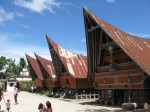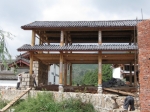We took a ferry across the Strait of Melaka from Penang to the port of Medan in Sumatra. After a little confusion at the port of Medan, our first stop in Sumatra was Danau Toba, a massive lake that was formed by a volcanic eruption thousands of years ago. We arrived late and stayed in the port city of Parapat, and the next day we crossed over to an island in the middle of the lake called Samosir. Read the rest of this entry »
Danau Toba, Sumatra
6 01 2010Comments : 2 Comments »
Tags: Danau Toba, Sumatra
Categories : Architecture, Indonesia
Dalat, Vietnam
24 10 2009Our next stop as we traveled south through Vietnam was Dalat. This highland town was a French resort area, and is known for its many French villas and the nice climate (not too hot and humid). They also grow many fruits and vegetables, with the agricultural areas on the outskirts covered with green-houses. It is also a base for many tours into the surrounding highlands, which are a mix of pine forests and productive agricultural lands (coffee, fruit, etc.). Here we did some adventurous canyon trekking.
Comments : 4 Comments »
Tags: Dalat, Hang Na
Categories : Architecture, Vietnam
Naxi Architecture
18 09 2009Yunnan province is known for the Naxi culture, but as city planners, we also were interested in Naxi architecture. Naxi traditional buildings are known for their quintessential tile roofs and wood framing, in addition to their resilience during earthquakes. Many of the traditional Naxi buildings withstood a recent earthquake, so the government has been encouraging builders to continue to use this style for new buildings. On a bike ride into the countryside north of Lijiang, we observed many new Naxi style buildings being built. Read the rest of this entry »
Comments : 1 Comment »
Tags: Naxi Architecture, Yunnan
Categories : Architecture, China
Lombok: Gili Air
20 07 2009From Amed we headed down to the city of Padang Bai, past the resort area of Candidasa, to catch the ferry over to the island of Lombok. We stayed the night in Padang Bai and the next day we arraigned our travel over to Lombok and the island of Gili Air. Lombok is a mostly Muslim island, compared to the predominately Hindu island of Bali. The Gilis (Trawagan, Meno and Air) are different than the rest of Lombok in that as small islands, there are no motorized vehicles on land (just horse carts). The rest of Indonesia is packed by motor scooters puttering around on the small roads, but these islands are tranquil thanks to the lack of motor vehicles. The sounds on the islands are limited to the ocean, crowing roosters, the call to prayer from the mosque, and the occasional late-night full-moon party. Read the rest of this entry »
Comments : 2 Comments »
Tags: gili air, lombok
Categories : Architecture, Indonesia
Zakopane, Poland
6 06 2009We left Krakow and headed south to Zakopane, near the Tatra mountains that separate Poland and Slovakia. We had planned to see the Tatras is Slovakia, but the weather turned cold and rainy (with snow in the Tatras), so we went to Krakow instead. We came to Zakopane with the hope of seeing some of the Tatras, regardless of the weather. Read the rest of this entry »
Comments : 1 Comment »
Tags: Stanisław Witkiewicz, tatras, zakopane
Categories : Architecture, Poland
Sighişoara
2 05 2009We took another day trip from our comfortable base in Braşov up north to the town of Sighişoara. It was a three hour train ride through more of the rolling hills of the Romanian countryside. We often saw horse-drawn wagons, old-fashioned domed mounds of grass (kept in fields or near barns) and many small farms as we passed by in the train. Sighişoara is another historical Saxon village similar to Braşov in that the original medieval core of the city is surrounded by walls and bastion towers associated with the various trade guilds, but this village is perched up on a hillside with great views of the surrounding river valley and forested hillsides. Read the rest of this entry »
Comments : Leave a Comment »
Tags: Anca Petrescu, Sighişoara
Categories : Architecture, Land Use Planning, Romania, Urban Design
Prague Spring
15 04 2009Prague is a real architectural and historic treat, and the spring here is nice. Now that we are back up in the northern hemisphere for spring, we see tulips blooming and the trees are putting on fresh leaves all over the city. Prague Castle is prominently located up on a slighlty tall hill, looking down on the city and the river. Charles Bridge leads to the castle and connects with the main old town square, which has the famous astronomical clock. All throughout the city there are awesome buildings with great detail work and architectural styles. Read the rest of this entry »
Comments : 2 Comments »
Tags: Czech, Museum of Communism, Prague Castle
Categories : Architecture, Czech Republic
Buenos Aires
11 04 2009We have been lucky to have been to this great city before, so this time we didn’ t spend as much time (or money) as we did our first time here. It is Santa Semana here, and many people have the entire week off, so it is fairly busy. We walked the major pedestrian avenues, went out to the massive Julio 9 Boulevard, walked through the artist area of San Telmo, saw performers dancing the tango in the street and had our final steak dinner in Argentina. Read the rest of this entry »
Comments : Leave a Comment »
Tags: Buenos Aires, El Zanjón
Categories : Architecture, Argentina, Land Use Planning
Buildings of Peru
29 01 2009Peru has a whole range of building construction styles, from the ancient to the modern. The ruins had three main types:
1. The finely made stone buildings which had the entire walls made of stone, and covered with wooden and thatch roofs (common at Machu Picchu and other ceremonial sites) with varying degrees of quality stonework. These often included stone pegs extending from the walls and carved stone rings to tie down and support the roofing rafters.
Comments : Leave a Comment »
Tags: Peru, Urban Design
Categories : Architecture, Peru










